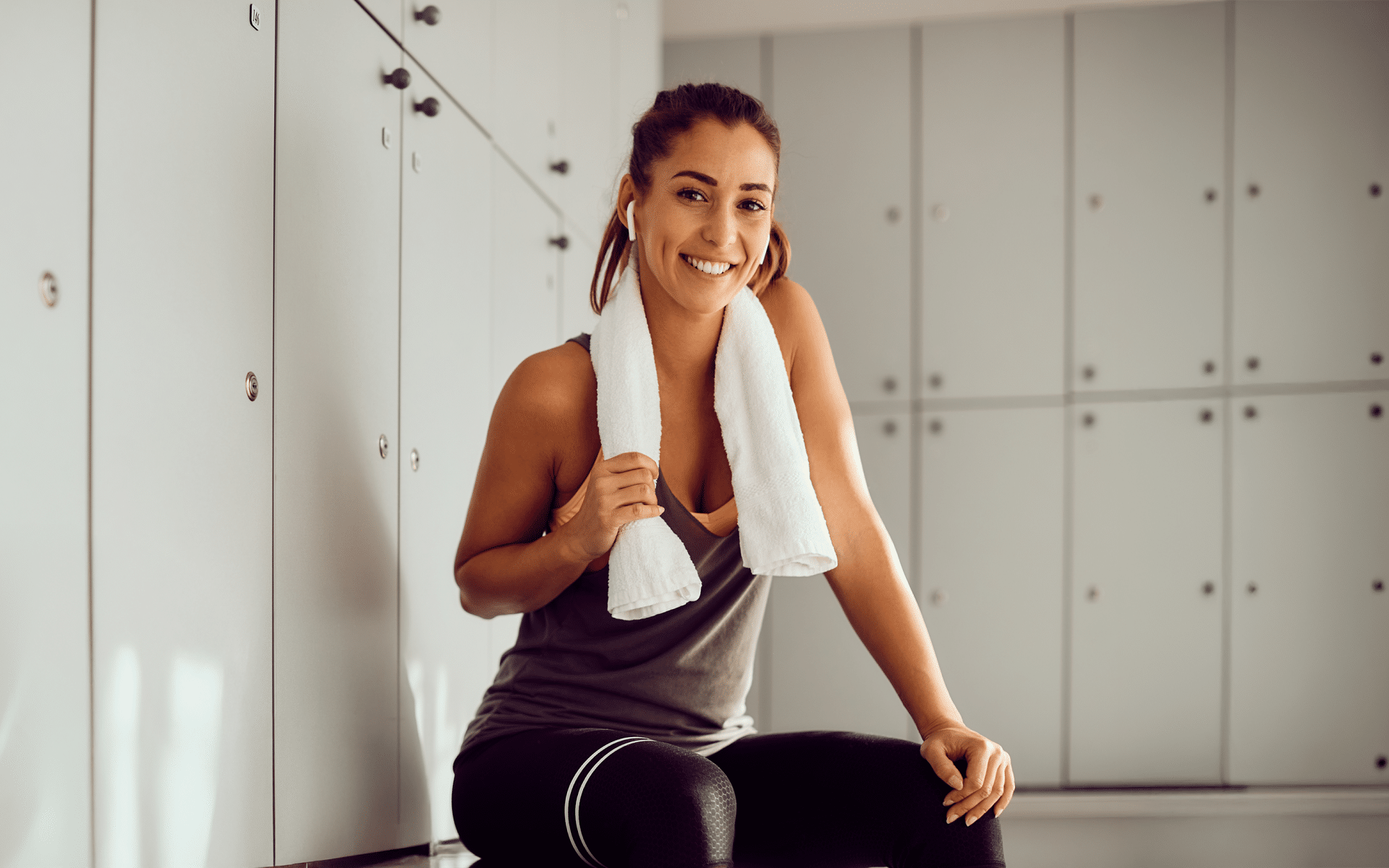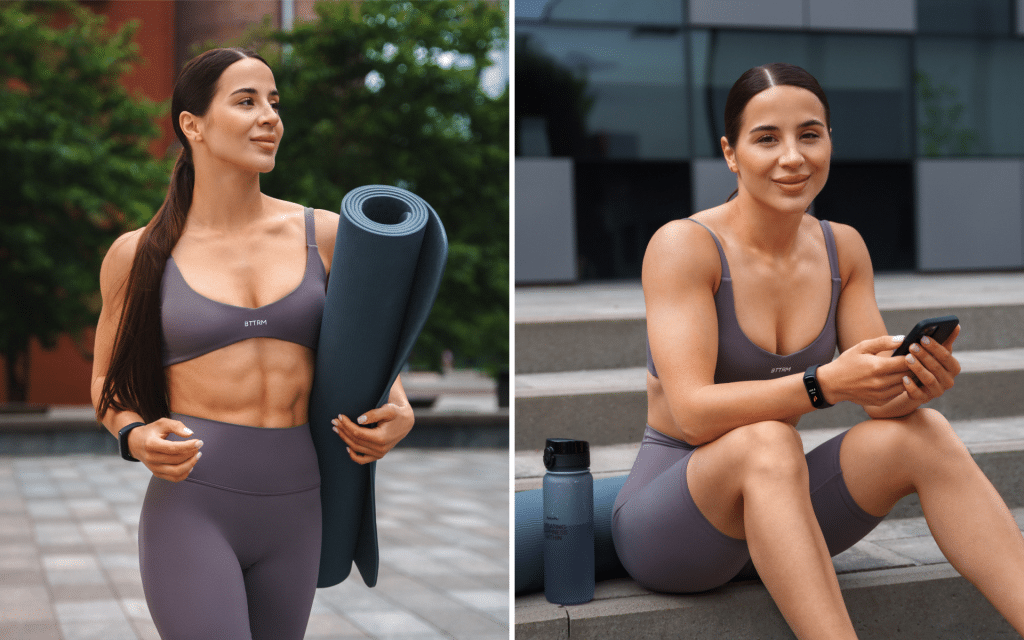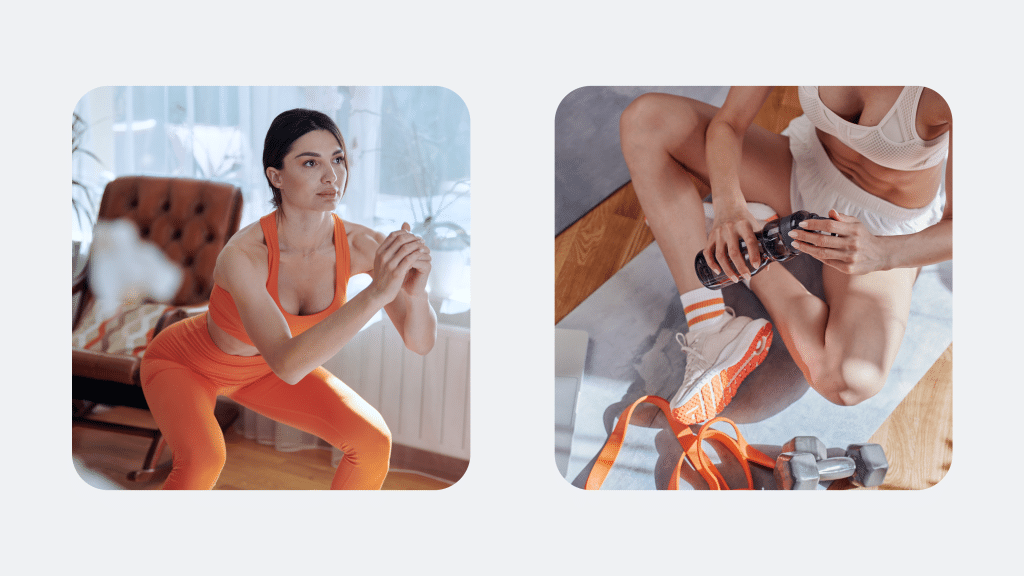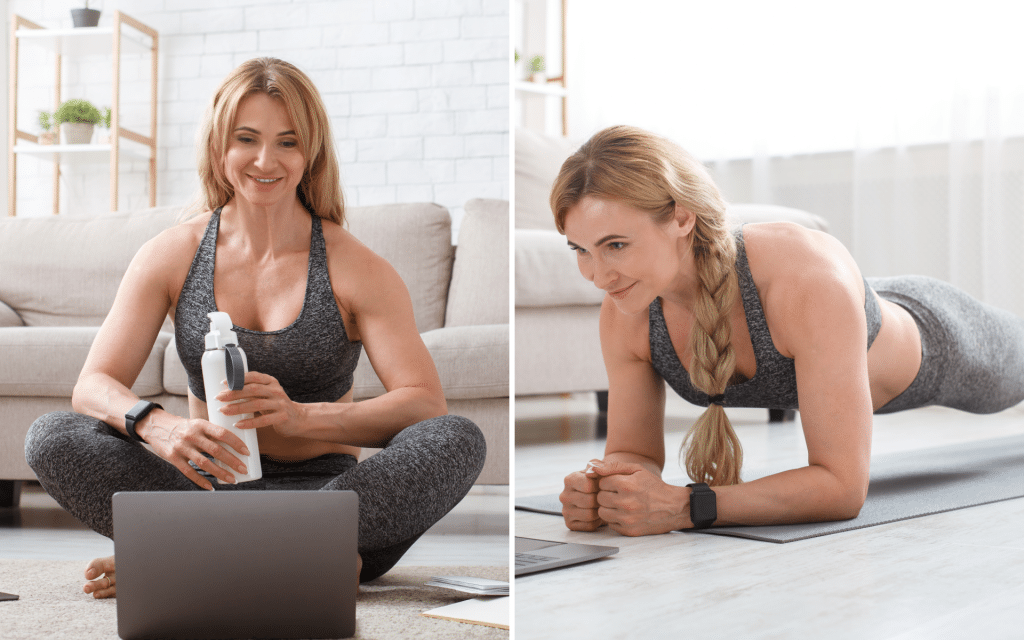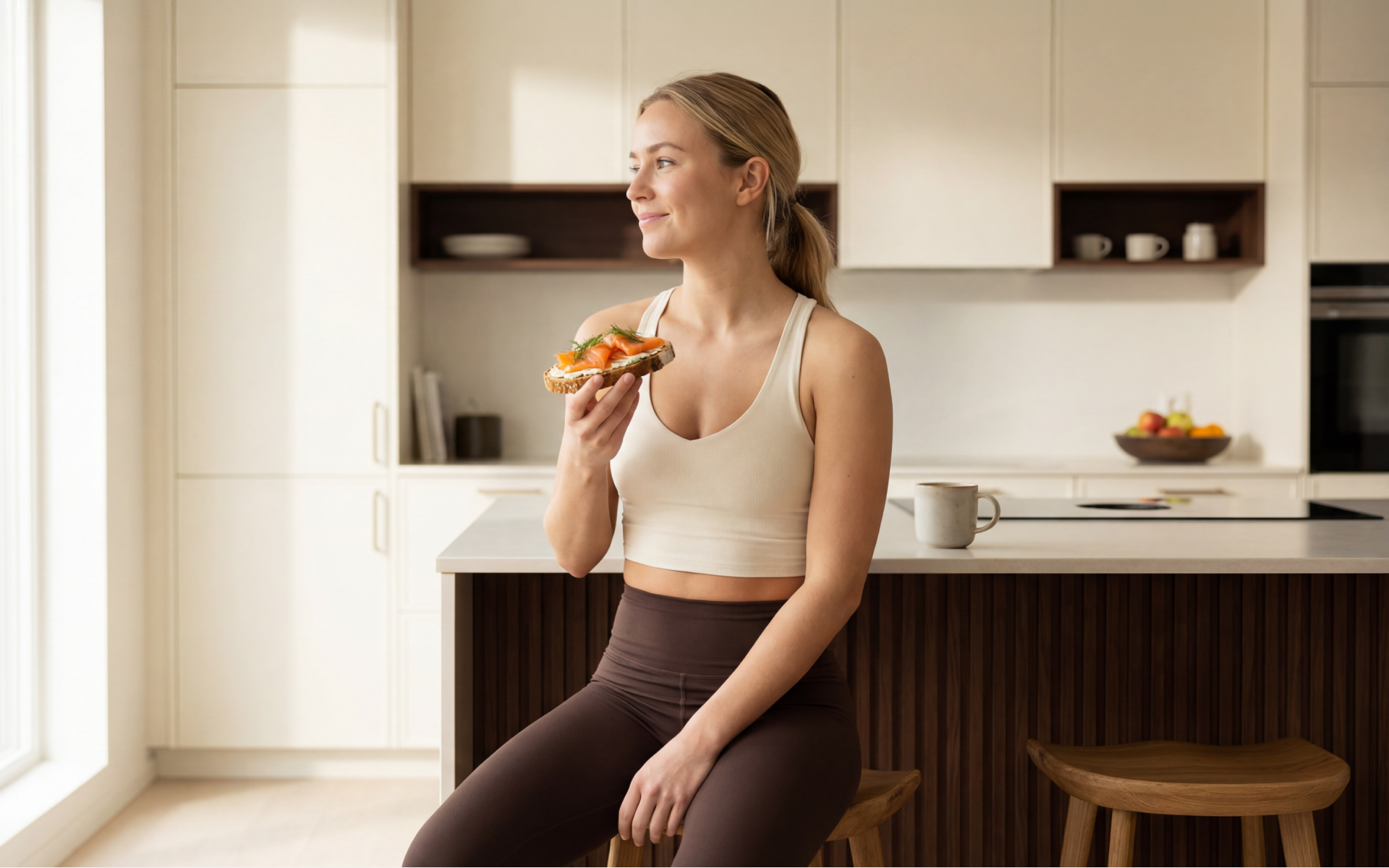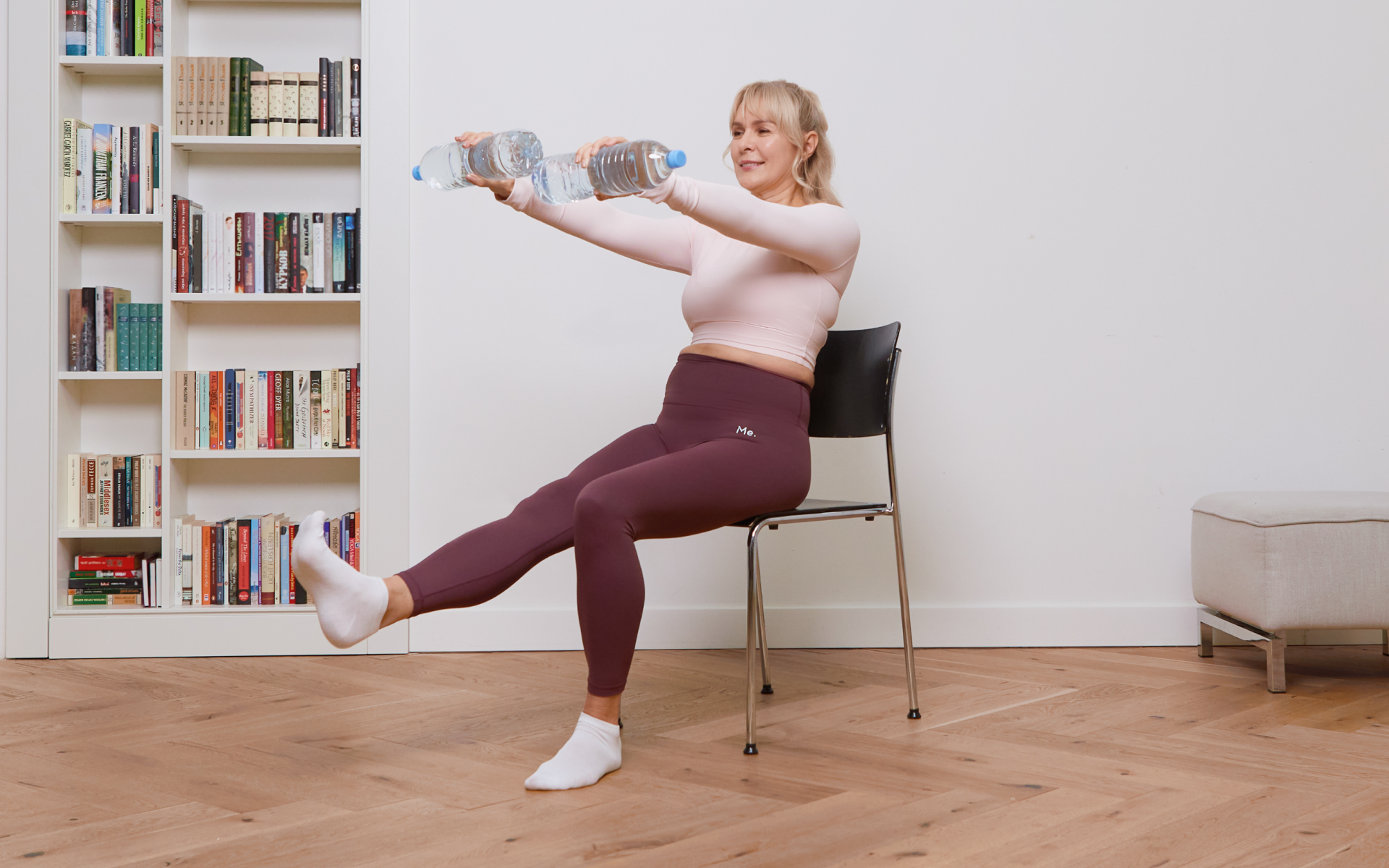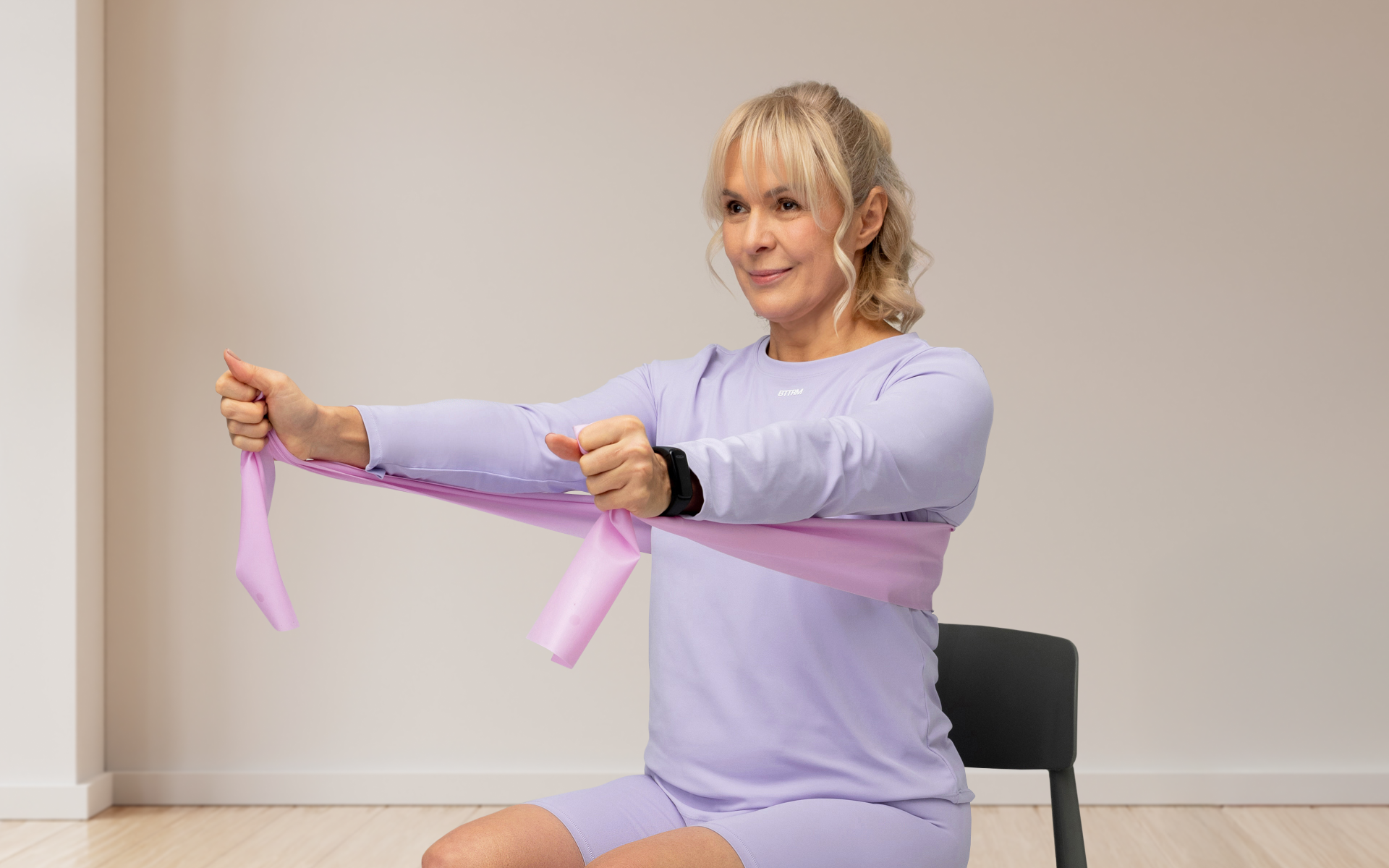There are many reasons to exercise, and looking fit is the main reason for most females.
We all want to achieve a toned, fit body that we can be proud of.
However, it’s not just about aesthetics – regular exercise and a healthy lifestyle also have numerous health benefits, such as:
- Increased energy levels
- Improved cardiovascular health
- Reduced risk of chronic diseases (1).
If you’re a female looking to achieve a toned body, it’s easy to get swept up in the latest fad diets and workout trends. But it’s important to remember that sustainability is key, and crash dieting or extreme workouts can do more harm than good in the long run.
To help you on your fitness journey, we pinned down the 6 realistic toned body goals female-focused and how to achieve them:
What Are Healthy Toned Body Goals For A Female?
Achieving a toned body isn’t just about aesthetics—it’s about fostering a strong, healthy, and sustainable lifestyle. Many trends promise quick results, but these often backfire, leaving you further from your goals.
Aiming for the following goals will give you a body you’re proud of, mainly if you stick to a healthy and consistent routine.
Here are the 6 fitness goals to answer any woman wondering, “What are some healthy toned body goals female-focused?”:
- Build Lean Muscle Mass
Muscle mass isn’t just for bodybuilders—it’s the foundation of a toned body and directly impacts how your body looks and performs.
Lean muscle:
- Gives your body shape
- Supports your metabolism
- Helps burn fat even when you’re resting.
Studies show muscle tissue burns more calories at rest than fat (2), making it a key ally in effective and efficient calorie use.
Resistance training is the best way to build lean muscle (3).
Incorporate compound movements in your workouts to target multiple muscle groups simultaneously.
Some compound movement examples are:
- Squats
- Deadlifts
- Push-ups
Aim for 2-3 weekly strength-training sessions, balanced with proper protein intake and recovery time (4).
To promote muscle growth, a general rule of thumb for protein intake is around 1.2–2.0 grams per kilogram of body weight daily (5).
- Focus On Body Fat Percentage, Not Weight
Pay attention to your body fat percentage instead of obsessing over the number on the scale. Body fat measurement indicates your composition—how much fat you carry versus lean mass.
Aiming for a healthy range (16–33% for women, depending on age and activity level) can help you achieve a toned and well-balanced physique without resorting to unsustainable weight-loss methods (6).
To reduce body fat while maintaining muscle, practice a combination of the following:
- Strength training
- A well-balanced diet
- High-intensity interval training (HIIT)
Focus on nutrient-dense foods like leafy greens, lean protein, whole grains, and healthy fats. Avoid drastic calorie deficits, leading to muscle loss and metabolic slowdown (7, 8).
- Improve Core Strength And Stability
A strong core is key to achieving a toned midsection and is vital in almost every movement you make.
Core strength:
- Enhances posture
- Reduces injury risk
- Stabilizes your body for better performance in other exercises (9)
This muscle stability goal is about functionality and aesthetics—tightening and strengthening your core muscles can lead to the appearance of a flatter stomach and increased definition.
Rather than relying solely on crunches, diversify your core exercises with:
- Planks
- Bird dogs
- Exercises involving rotational movements like Russian twists
- Compound exercises like deadlifts and squats deeply engage your core
Add these to your routine to benefit your entire body. Aim for core-focused exercises 2-3 times weekly, and use proper form to brace your core with any lift.
Whether you’re a workout beast or just a beginner making your first foray into the world of fitness and dieting – BetterMe has a lot to offer to both newbies and experts! Install the app and experience the versatility first-hand!
- Cultivate Functional Strength
While toned arms and legs look great, functional strength ensures you can perform daily activities efficiently and without strain.
This functionality includes:
- Upper-body strength for lifting
- Full-body balance and coordination.
- Lower-body strength for climbing stairs
Full-body workouts incorporating these aspects are ideal for gaining functional strength (10):
- Weightlifting
- Flexibility training
- Bodyweight exercises
For example, kettlebell swings, lunges, and push-pull movements (like rows and push-ups) target muscles required for daily movement.
Ensure you’re working your larger and smaller muscle groups, as imbalances can lead to injury over time.
- Prioritize Cardiovascular Endurance
Cardiovascular health is vital for burning calories, improving overall fitness, and giving your body that lean, sculpted appearance (11).
A healthy heart supports all your workouts, helping you perform better during resistance and strength training.
Cardiovascular endurance ultimately increases your strength and reduces body fat.
Health experts recommend 150 minutes per week of moderate-to-vigorous aerobic exercise, such as:
- Cycling
- Jogging
- Swimming (12)
To boost fat loss efficiently, you can also incorporate HIIT sessions (13).
The bonus benefit? Cardiovascular exercise releases endorphins, which improve mood and reduce stress. An uplifted mood plays a role in appetite regulation and maintaining healthy habits (14).
- Commit To Recovery And Flexibility Training
A toned body is not just about working hard—it’s about recovering smartly, too.
After a workout, your muscles need time to rebuild and grow, which is when the real progress occurs.
Incorporating flexibility and mobility training into your routine will:
- Reduce soreness
- Improve range of motion
- Help your body perform better during workouts (15).
Include dynamic and static stretches in your warm-up or yoga in your cooldown.
Practices like foam rolling or targeted mobility exercises can relieve muscle tightness and increase circulation (16, 17).
Adequate sleep is also essential for recovery, so aim for 7–9 hours of quality sleep each night to help your body rebuild tissue and regulate hormones tied to muscle growth and fat loss (18).
Read more: 3 Examples Of Wall Pilates Exercises And Their Benefits
What Does A Toned Female Body Look Like?
From a physical standpoint, a toned body often features visible muscle definition, resulting from lean muscle mass combined with a healthy body fat percentage.
Body fat percentage plays a significant role in how toned muscles appear.
A healthy range for women is around 16–33%, depending on factors like age and activity level (6). However, it’s important to remember that muscle definition will look different on various body types.
Crucially, a toned body isn’t limited to one shape or size.
Women come in all body types—athletic, curvy, petite, tall—and a toned physique will look different depending on genetics, lifestyle, and individual goals.
For example, one woman may have pronounced arm and shoulder definition, while another might focus on building strength and tone in her legs and core. Both are equally valid representations of a toned body.
What Exercises Are Best For Overall Toning?
You must strengthen your entire body to achieve this “toned” look.
Various exercises targeting different muscle groups and incorporating strength, cardio, and flexibility can help achieve a toned physique.
Creating a balanced workout routine will build lean muscle, reduce body fat, and boost your overall fitness.
Here are some of the best toned body goals female exercises:
1. Squats (Compound Movement)
Squats are excellent for toning your lower body, targeting the glutes, quads, hamstrings, and core. They also improve strength and stability.
How to do it:
- Stand with your feet shoulder-width apart, toes slightly turned out.
- Keep your chest lifted and your eyes forward as you engage your core.
- Push your hips back as if sitting in a chair, bending your knees and lowering your body.
- Lower until your thighs are parallel to the ground or slightly below, making sure your knees don’t cave inward.
- Push through your heels to stand back up, squeezing your glutes at the top.
Tip: Start with bodyweight squats and progress to using dumbbells or a barbell for added resistance.
2. Push-Ups (Bodyweight Exercise)
Push-ups are a classic move to tone the chest, shoulders, triceps, and core.
They’re adaptable to all fitness levels.
How to do it:
- Begin in a high plank position with your arms fully extended and hands slightly wider than shoulder-width apart.
- Keep your body in a straight line from head to heels—tighten your core and avoid sagging hips.
- Bend your elbows, lowering your chest toward the floor while keeping your elbows at about a 45-degree angle to your body.
- Push back up to the starting position, fully extending your arms.
Tip: Modify by lowering your knees to the ground or performing push-ups against a bench if needed.
3. Deadlifts (Compound Movement)
Deadlifts work your hamstrings, glutes, back, and core—key areas for creating a balanced, muscular physique.
How to do it:
- Stand with your feet shoulder-width apart, with a barbell or dumbbells in front of you.
- Grip the bar or weights with your hands slightly wider than your legs.
- Hinge at your hips, keeping your back flat and chest up as you lower the weight toward the floor.
- Engage your glutes and hamstrings to lift the weight as you return to standing.
- Lower the weight back down in a controlled motion, maintaining good form throughout.
Tip: Start with light weights until you’re confident in your technique.
4. Plank Variations (Core-Focused)
Planks are a go-to for building core strength and stability, which enhance your posture and overall fitness.
How to do it:
- Begin in a forearm plank position with your elbows under your shoulders and your forearms parallel to the ground.
- Keep your body straight from head to heels, engaging your core and glutes.
- Hold this position for 20–60 seconds, focusing on maintaining form.
Tip: Progress to side planks, plank shoulder taps, or plank reaches to challenge yourself further.
5. Lunges (Bodyweight or Weighted)
Lunges are fantastic for toning your legs and glutes while improving balance.
How to do it:
- Stand with your feet hip-width apart. Step one foot forward.
- Bend both knees to lower your body, ensuring your front knee stays directly above your ankle and your back knee points toward the floor.
- Push through your front foot to return to the starting position and repeat on the other side.
Tip: Hold dumbbells at your sides or over your shoulders to increase resistance.
6. Pull-Ups or Assisted Pull-Ups (Upper Body and Back)
Pull-ups are advanced moves that target the back, shoulders, biceps, and core.
Assisted variations can help you build strength if you’re a beginner.
How to do it:
- Grip a pull-up bar with your hands shoulder-width apart, palms facing away from you.
- Engage your back and pull your chest toward the bar, keeping your elbows close to your body.
- Lower yourself with control, fully extending your arms.
Tip: Use a resistance band or an assisted pull-up machine until you can perform unassisted repetitions.
7. Kettlebell Swings (Full-Body Movement)
Kettlebell swings combine strength and cardio, working your glutes, hamstrings, core, and shoulders.
How to do it:
- Stand with your feet slightly wider than shoulder-width apart, with a kettlebell in front of you.
- Bend at the hips and knees to grip the kettlebell with both hands.
- Swing the kettlebell between your legs, then drive your hips forward powerfully to swing it up to chest height.
- Allow the kettlebell to swing back between your legs as you hinge at the hips.
Tip: Keep your back straight and focus on using your hips, not your arms, to propel the movement.
Reasons why BetterMe is a safe bet: a wide range of calorie-blasting workouts, finger-licking recipes, 24/7 support, challenges that’ll keep you on your best game, and that just scratches the surface! Start using our app and watch the magic happen.
8. High-Intensity Interval Training (HIIT)
HIIT involves alternating between short bursts of intense effort and brief periods of rest or lower-intensity activity.
Exercises like burpees, mountain climbers, and jump squats are common in HIIT circuits, helping you burn calories and promote fat loss while building muscle.
It’s a time-efficient way to enhance cardiovascular fitness and muscle tone (19).
9. Yoga or Pilates (Flexibility and Core Strength)
Flexibility and recovery are as important as strength and cardio in toning.
Yoga and Pilates improve flexibility, mobility, and core strength (20), making them perfect for lengthening and toning muscles.
Poses like downward dog, boat pose, and warrior variations shape muscles subtly while improving balance and posture.
Check out our Flat Stomach Pilates guide and learn how this exercise can help support your body toning goals.
10. Rowing (Cardio and Strength Combo)
Rowing machines are excellent for a full-body workout involving cardio and strength training.
The pulling motion targets your back, arms, and shoulders, while the leg drive works your glutes and quads (21). A 20-minute session on the rowing machine can tone your muscles while giving you a cardiovascular boost.
We discuss how to sculpt your arms in our earlier publication – Toned Arms Workout.
Creating a Balanced Routine
For total-body toning, combine these elements in your weekly workout plan:
- Strength Training (e.g., squats, deadlifts, lunges) 2–3 days a week to build and define muscles.
- Cardiovascular Exercise (e.g., HIIT, rowing, or jogging) 2–3 days a week to burn fat and enhance endurance.
- Flexibility Training (e.g., yoga, Pilates, or stretching) Daily sessions are ideal for flexibility and mobility. They can improve recovery and prevent injuries.
Aim for stretching after each cardio or strength training session you complete.
Read more: Calisthenics Supersets: Effective Workouts to Build Strength and Endurance
How Many Reps For Female Toning?
For toning, focus on 8–12 reps per set using moderate weights that challenge your muscles while maintaining proper form. This range helps build lean muscle. Aim for 2–3 sets of each exercise, depending on your fitness level.
How Long Does It Take To Get A Toned Body For A Female?
The time frame depends on starting fitness level, workout intensity, and consistency.
On average, noticeable toning can take 6–12 weeks with strength training, cardio, and a balanced diet. Patience and persistence are key.
Check out our previous post about the 4 Month Weight Lifting Transformation Female Plan and see how consistency goes a long way in helping you achieve your goals.
How To Tone A Female Body Quickly?
While “quickly” depends on your definition, combining consistent strength training, high-intensity interval training (HIIT), and a clean, protein-rich diet can accelerate visible results. However, avoid shortcuts or overly restrictive diets that may harm your health.
How To Tell If I Am Reaching My Toned Body Goals?
Signs of progress include increased muscle definition, improved strength, less body fat, better endurance, and a positive change in how your clothes fit.
Regular progress photos, measurements, or fitness benchmarks, like lifting heavier weights, also indicate success.
Yes, 30 minutes of toning can be effective if done consistently and with proper intensity. Combining strength training with compound movements and minimal rest between sets can maximize results. Squats indirectly help reduce belly fat by building muscle and boosting overall calorie burn. However, you need strength training, cardio, and a calorie-controlled diet to lose belly fat, as fat loss requires an overall caloric deficit. The number of squats depends on your fitness level and goals, but 3 sets of 10–15 reps is a good starting point. Progress by increasing resistance or reps over time as your strength improves. The 130-hour rule suggests that it takes about 130 hours of deliberate practice to see noticeable results in a specific skill or goal, such as toning your body. For example, working out 3–5 hours a week could show results in about 6–12 months with consistent effort.Frequently Asked Questions
Is 30 minutes of toning enough?
Do squats reduce belly fat?
How many squats should I do a day?
What is the 130 hour rule?
The Bottom Line
Achieving a toned female body isn’t just about appearances.
It reflects a lifestyle that prioritizes regular movement, a well-rounded diet, and mindful self-care. This foundation supports muscle definition and improved endurance, strength, and overall physical health.
A toned body isn’t a one-size-fits-all accomplishment—it’s about appreciating and working with your unique body to feel strong, confident, and empowered.
By cultivating lean muscle, managing body fat percentage sustainably, improving core and functional strength, and prioritizing cardiovascular health and recovery, you’ll create a balanced routine that strengthens your body and supports long-term progress.
DISCLAIMER:
This article is intended for general informational purposes only and does not serve to address individual circumstances. It is not a substitute for professional advice or help and should not be relied on for making any kind of decision-making. Any action taken as a direct or indirect result of the information in this article is entirely at your own risk and is your sole responsibility.
BetterMe, its content staff, and its medical advisors accept no responsibility for inaccuracies, errors, misstatements, inconsistencies, or omissions and specifically disclaim any liability, loss or risk, personal, professional or otherwise, which may be incurred as a consequence, directly or indirectly, of the use and/or application of any content.
You should always seek the advice of your physician or other qualified health provider with any questions you may have regarding a medical condition or your specific situation. Never disregard professional medical advice or delay seeking it because of BetterMe content. If you suspect or think you may have a medical emergency, call your doctor.
SOURCES:
- The Health Benefits of Exercise and Physical Activity (2016, link.springer.com)
- Greater Skeletal Muscle Oxidative Capacity Is Associated With Higher Resting Metabolic Rate: Results From the Baltimore Longitudinal Study of Aging (2010, ncbi.nlm.nih.gov)
- A Systematic Review with Meta-Analysis of the Effect of Resistance Training on Whole-Body Muscle Growth in Healthy Adult Males (2020, ncbi.nlm.nih.gov)
- PROTEIN INTAKE FOR OPTIMAL MUSCLE MAINTENANCE (2020, acsm.org)
- Protein timing and its effects on muscular hypertrophy and strength in individuals engaged in weight-training (2012, ncbi.nlm.nih.gov)
- Body Composition: Health and Body Fat (2024, webmd.com)
- Metabolic Consequences of Weight Reduction (2023, ncbi.nlm.nih.gov)
- Impact of calorie restriction on energy metabolism in humans (2020, ncbi.nlm.nih.gov)
- Core exercises: Why you should strengthen your core muscles (2022, mayoclinic.org)
- Four Types of Exercise Can Improve Your Health and Physical Ability (2021, nia.nih.gov)
- Cardiovascular Effects and Benefits of Exercise (2018, ncbi.nlm.nih.gov)
- American Heart Association Recommendations for Physical Activity in Adults and Kids (2024, heart.org)
- The Effect of High-Intensity Interval Training Type on Body Fat Percentage, Fat and Fat-Free Mass: A Systematic Review and Meta-Analysis of Randomized Clinical Trials (2023, ncbi.nlm.nih.gov)
- Role of Physical Activity on Mental Health and Well-Being: A Review (2023, ncbi.nlm.nih.gov)
- Stretching: Focus on flexibility (2023, mayoclinic.org)
- A Meta-Analysis of the Effects of Foam Rolling on Performance and Recovery (2019, ncbi.nlm.nih.gov)
- The Surprising Benefits of Performing Daily Mobility Exercises (2023, acefitness.org)
- Sleep and muscle recovery: endocrinological and molecular basis for a new and promising hypothesis (2011, pubmed.ncbi.nlm.nih.gov) 18
- Evidence-Based Effects of High-Intensity Interval Training on Exercise Capacity and Health: A Review with Historical Perspective (2021, ncbi.nlm.nih.gov)
- Yoga vs. Pilates: The Differences Between Two Great Exercises (2024, health.clevelandclinic.org)
- Catch, Drive, Finish and Recover! The Top 7 Benefits of Rowing Machines (2024, health.clevelandclinic.org)
